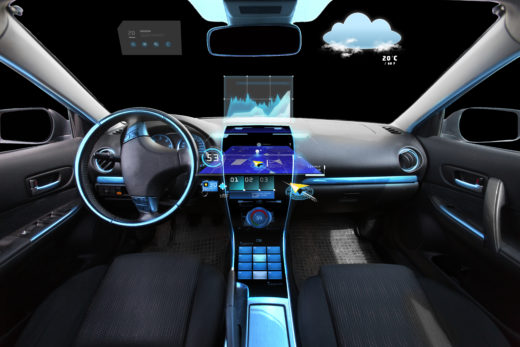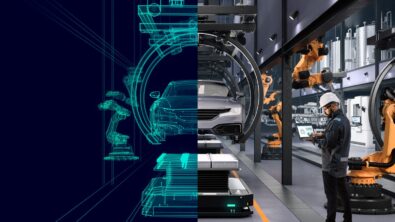The new automotive supply chain is horizontal
We have talked in the past about the new automotive supply chain, and the challenges of system design in automobiles today. No single player has all the capabilities in-house to deliver a full autonomous drive system or connected car platform, and new industry entrants that throw massive resources in these areas are finding the learning curve for automotive grade platforms to be challenging.

So how is this all going to evolve?
Before answering, consider how things used to work. The SoC vendor would design a chip, with a Tier 1 following the development milestones and then integrating the silicon into a hardware and software system. Eventually the box would be handed over to the OEM to integrate into its vehicle architecture.
That model worked fine for years. Adding new features mostly meant adding another ECU onto the network while everyone in the supply chain found cost reductions through the introduction of smaller chip geometries or materials optimization.
Now the network is starting to reach a breaking point. Software systems are becoming unmanageably complex, and ‘new features’ such as connected car technologies or autonomous drive are not just thrown over the wall anymore as a single ECU box.
So now we are seeing lots of collaboration to develop these new complex systems, and rightly so. But there are more questions than answers, the big one being — how’s all this going to shake out? The good thing about blogs is the freedom to throw out predictions and opinion based on gut feel so here’s my unscientific opinion.
We will see the emergence of something that looks like a Tier 1.5, bridging between the tiers and contributing to the systems engineering effort and design optimization. You probably think this is a sound bite solution looking for a problem, and are wondering what this new kind of tier would do?
Well several things, actually.
First, optimum system design. Take autonomous drive: today we have generally an aggregation of preexisting solutions, with one vendor providing the vision part of it, another one radar, someone else the neural network. The Tier 1 has to figure out how to stitch all these components together.
My hypothetical Tier 1.5 would start with the solution, in different component parts, then try to figure out how to optimize their integration. The missing part — and the big opportunity — is defining what an optimum AD system looks like. Before we all get in a room chipping in our bit, and frankly trying to make our part of the system the cornerstone of the platform, we need to define the optimum data structures, what is really needed and what’s superfluous, and at what stage of the process. What’s the optimum sensor configuration, where is the data processed, and when is it fused together? What’s an impartial look at the system requirements reveal?
We are all familiar with the V-model, and generally it starts with something like the functional and logical operations, then requirements and architecture. Today we are skipping too quickly to the design phase and not placing enough emphasis on system requirements or on working hard to build the systems engineering base platform.
This leads to the second challenge: automotive-grade, production intent solutions. The automotive industry is flexing increasingly towards general market technologies which are then productionized and qualified as automotive grade. Infotainment platforms were the first to require lots of consumer-type technologies and bring them into the vehicle. SoCs sold into automotive need zero-defect reliability, operating systems need to be hardened, and the whole system has to be manufacturable in high volume, at high production yields, for cost competitiveness.
This doesn’t sound like a trivial exercise, and it’s not. We cannot build automotive-grade quality nor reliability into systems after design. SoCs have automotive design rules for reliability and manufacture/test; the chip structure is physically different from consumer grade. Extrapolate to an autonomous drive system with multiple different sensors and layer upon layer of complex software, and new technologies such as neural networks to be engineered into the platform. Designing for automotive grade is at the top of that V-cycle.
The Tier 1 today plays a strategic role in executing on the car OEM system strategy, adding the layers of differentiation onto the base software and hardware platform that allows them to offer, for example, an innovative user interface and a differentiated in-car experience. Here is where the new wave of Tier 1.5’s must step up and provide these complex, optimized automotive-grade software and hardware platforms, that’s something like 90% production-ready, in collaboration with existing suppliers.
This stretches the automotive supply chain in a positive way, enabling all players to add more value, and maintaining automotive systems engineering excellence. The good news for you and me is faster design cycles, and more quickly getting our hands on cool automotive gadgetry in our cars. But of course the main benefit has to do with gadgetry that is designed to save lives and make millisecond decisions on safety-critical functions, so automotive-grade at the system level is non-negotiable.
This leads to the third challenge: the automotive supply chain is now more horizontal than vertical; automotive electronics design needs a long-term roadmap of digital and mixed-signal processors, analog actuators, sensors and software. The Tier 1 needs to stay aligned to the carmaker’s long-term strategy and execute on that. The silicon vendors are doing a good job of wrapping automotive software around their processors. How do we create a long-term technology roadmap that starts with the carmaker’s vision, middles with the long-term base platform system design requirements, and ends with a subset of the horizontal supply chain all aligned and designing to those requirements? This will be crucial to accelerating the development of concepts like autonomous drive, and connected car technology.

In automotive electronics it can be (relatively) easy, to develop a prototype system of something like autonomous drive. We can quadruple the system for redundancy and functional safety; we can add in all kinds of extra processing to manage neural networks; we can forget, for the time being, about things like power consumption and have the thing running as hot as the dryer in your laundry room. But the automotive industry only tolerates these kinds of prototypes for a short time.
The reality of the production schedule, the bill of materials cost, the load on the rest of the vehicle architecture, the quality and reliability mandates, and the ability to manufacture in high volume without throwing away every second unit soon becomes the reality. This is the challenge hidden among the daily news stories we see about self-driving cars that will talk to road signs, go buy your coffee, and take your dog to the vet.
The new automotive supply chain needs some glue in its increasingly horizontal structure, and, as this is a blog and anything goes, I’d contend that those players who decide that solving these problems pro-actively and getting back to the engineering structure of system requirements before design, however unfashionable that sounds, will ultimately see a competitive advantage for doing so.
Andrew Macleod is director of automotive marketing at Mentor Graphics. Read his last post, “5 Things You Didn’t Know About Electric Vehicles,” here.


